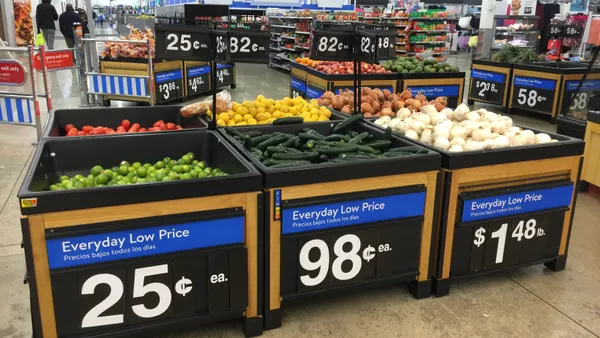Dive Brief:
- As automated technology continues to spread across the grocery industry, startup Cleveron has unveiled a new robotic pickup kiosk that can retrieve customer orders within 20 seconds, according to a company press release emailed to Grocery Dive.
- Workers fill the robotic kiosk with grocery orders, then customers scan a mobile QR code or enter a passcode at the console to retrieve their groceries. The unit operates similar to an order vending system Walmart began testing in 2017 at a store in Oklahoma, though a different company manufactures that system. Cleveron also manufactures Walmart's Pickup Towers, which store non-grocery pickup orders for customers and debuted in stores three years ago.
- The Cleveron unit comes in two sizes — a 23-foot-long version and a 43-foot-long one. Both are roughly the width of a parking spot. The smaller unit holds 124 crates while the larger unit holds 276 crates. Each crate can be manufactured with one or two temperature zones to accommodate perishables, general merchandise and frozen goods.
Dive Insight:
Automation has unfolded across stores, checkout lanes and fulfillment warehouses as grocers seek to boost efficiency in their operations and improve the customer experience. Now, advanced robotics promises to make order pickup faster and more convenient.
The concept of pickup kiosks isn't new. Hy-Vee has rolled out pickup lockers both at stores and at sites like hospitals that are situated close to shoppers. Customers place their order online, specify their pickup point and then enter a passcode at their designated locker. Amazon has rolled out pickup lockers that operate by a similar system and have become valuable to consumers who appreciate the added security and flexibility in gathering their orders.
Cleveron's new kiosk — officially known as the Cleveron 501 — is notable because it further automates the pickup process, providing a quick check-in system and a single order retrieval point. The system promises 24/7 order access and can be placed away from stores and closer to high-density apartment and office buildings.
Although pickup is generally known in the industry as a solution for suburban markets, kiosk technology could help the service expand in urban markets. A key factor will be how quickly grocers are able to turn orders around for shoppers. In an emailed interview with Grocery Dive, Cleveron co-founder Indrek Oolup said units placed close to stores could be filled "in minutes," however the time it takes to fill units placed away from stores will vary by driving distance, order logistics and other factors.
In an interview earlier this year, Keith Anderson, senior vice president of strategy and insights with Profitero, told Grocery Dive that grocery pickup kiosks add another layer of convenience to retailers' e-commerce services. But the service "hasn’t taken the world by storm," he said, mainly due to high upfront costs and the cost of scaling the units.
Walmart chose Cleveron to manufacture its popular Pickup Towers beginning in 2016. After a successful trial, the retailer will bring around 1,600 pickup towers to stores across the U.S. and Canada. In 2017, the retailer partnered with another company to bring large grocery kiosks to an Oklahoma City store. It added an additional pilot location in Sherman, Texas last fall. The kiosks allow customers to pick up online orders without interacting with an associate. Walmart employees fill orders inside the stores and organize them in bins or cold storage refrigerators and freezers. Customers are not charged extra for using the kiosk but are required to spend at least $30.
Cleveron told Grocery Dive via email that it did not design the 501 with Walmart specifically in mind, but the retailer looms large in the space, with more than 3,000 locations set to offer store pickup by the end of this year. It is the most popular grocery pickup service in the US, attracting new, high-value customers the company wants to convert into loyal shoppers.
Grocers are exploring a variety of ways to expand pickup, like building pickup-only depots and incorporating technology like geofencing that reduces customer wait times. The service, which mostly relies on curbside fulfillment outside store locations, is a key e-commerce entry point for shoppers. According to a study from Cowen, grocery click-and-collect will bring in $35 billion by 2020.
“From our experience, grocers all over the world, including the U.S., are already looking for efficient and convenient grocery pickup solutions.” Oolup said.












